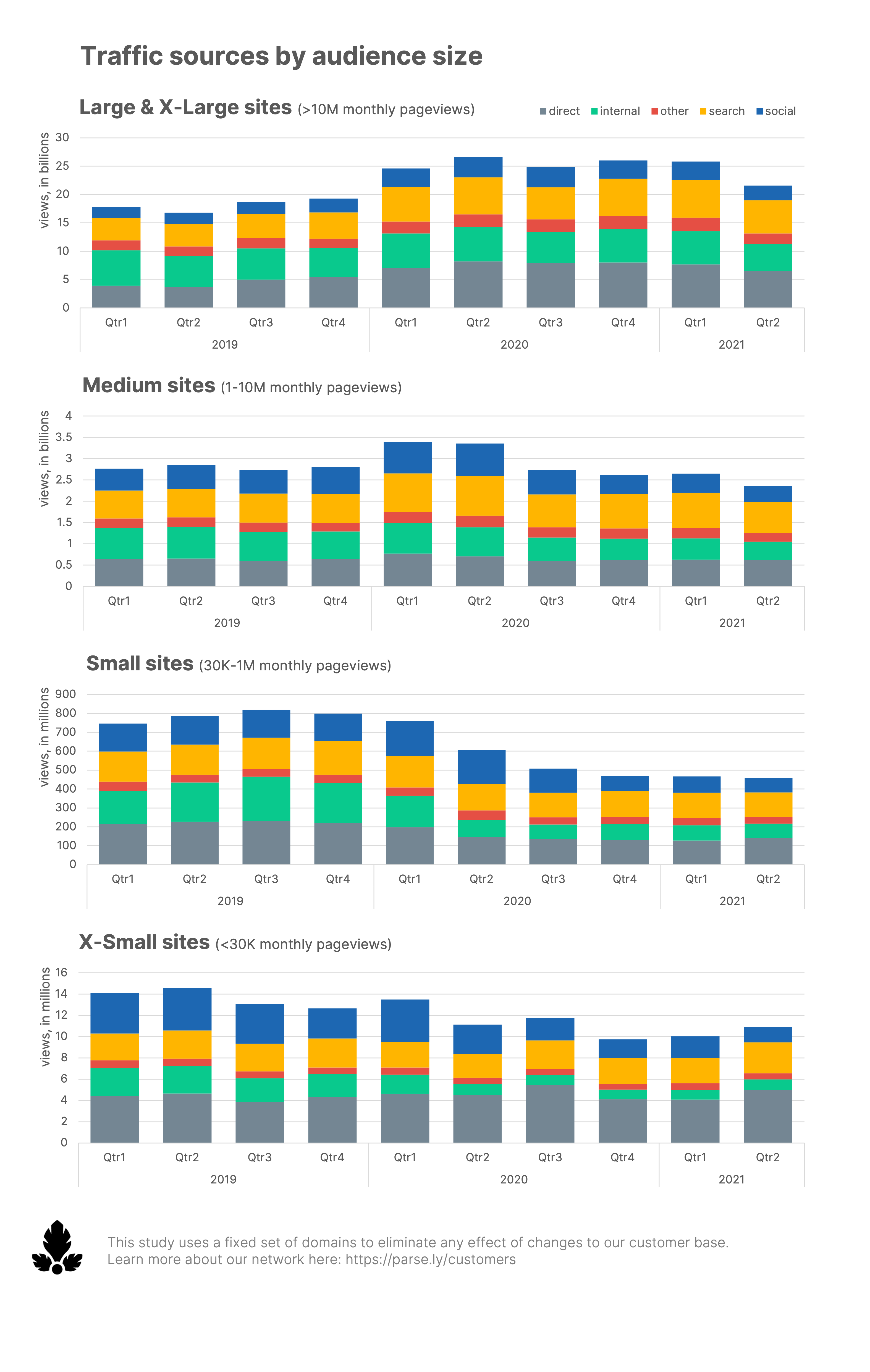Post-COVID traffic declines set some sites back two years

Going into 2020, publishers wondered whether their site traffic, after being lifted all year by a nearly relentless news cycle, might come down to earth.
It turns out it has for most of them, but those with the smallest audiences have taken the steepest falls, according to new Parsely data compiled for Digiday.
While publishers’ traffic across the board has declined from their 2020 peaks — through the first half of 2021, traffic across a 1,400-site sample in Parsely’s network is down 10% compared to the same period last year — the drops for many small publishers have been so steep that they are now behind where they were in 2019 in terms of pageviews.
Through the first half of this year, traffic to sites that gather between 30,000 and 1 million pageviews per month in Parsely’s network is down 40% from the same period in 2019. For even smaller sites, traffic is down 27% over those same periods.
The largest publishers in Parsely’s network — defined as those with more than 10 million pageviews per month — provide an exception to this rule. Collectively, those sites have generated more traffic through the first half of 2021 than they did over the same period in 2019. Gains in direct (up 79% half over half) and search (up 49%) traffic are the biggest reasons for the growth, according to the data.
There are lots of possible explanations for the drop, some more benign than others. But the high-level data underlines the reality that publishers’ priorities must continue to evolve as the world fights to move on from the shocks of last year.
“The sky is not falling…yet,” said Kelsey Arendt, data analysis lead at Parsely. “Fewer visitors might mean more valuable, more engaged ones, as well as just healthier relationships with advertising, with Facebook.”

Treating news fatigue
It is hard not to look at the year’s data through the prism of the ongoing pandemic. Though the uptick in cases caused by the delta variant have put much of the country on edge again, sources at several publishers theorized that the arrival of the vaccine this spring allowed millions of Americans to step away from their computers and do something with their time.
“I think there’s burnout from the news,” said Dan Petty, the director of audience and engagement at MediaNews Group, which owns numerous news publications, including The Denver Post. “The election was long; COVID’s been long. I think people are tuning out and looking to put their energy elsewhere.”
Broadened paywall implementation is another possible reason. While most publishers committed to keeping news about the pandemic freely accessible last year, many also tightened their paywalls on everything else, meaning that as interest in COVID coverage declined, the effects of constricted paywalls remain: For sites generating up to 10 million monthly pageviews, internal referrals are down 42%.
“We objectively have tighter paywalls than we did in 2019,” Petty added. “Where we’ve really seen a lot of growth is our unique opt-ins for newsletters. Clicks from newsletters are generally on an upward trajectory.”
Drowned out
But the biggest dip for most of the smallest publishers in Parsely’s network came from social media, mostly from Facebook. For sites that normally draw between 1 million and 10 million pageviews per month, social media referral traffic in the first half of this year is down 31% from where it was in 2019. For smaller publishers, the declines were even worse.
Because larger publishers did not experience the same kinds of drops, it’s possible lockdowns from last year drove publishers to produce more content, partly to keep up with the torrent of news happening around the country but also to keep entertaining everybody stuck at home.
That increase in post volume was difficult for smaller publishers to match.
“Post volume is a huge part of this,” said an audience development executive at one large digital publisher, who asked not to be identified while discussing the industry overall. “When you think about the sheer competition for social distribution, for search engine ranking, even distribution through third party aggregators…it’s become even harder for publishers who don’t have the resources to publish more.”
Above and beyond post volume, search and social ought to be thought of as zero-sum games, a dynamic that favors larger publishers, Ranker CEO Clark Benson said. “The bigger sites are holding their own and the smaller ones are seeing less traffic,” he added.
In either case, some see the drop as a necessary, if painful, step forward for publishers. “The industry has had a very unhealthy relationship with social [media] for many years,” Arendt said. “I’m wondering if these sites are developing a more healthy relationship.”
More in Media

From sidelines to spotlight: Esports events are putting creators center stage
Esports events’ embrace of content creators reflects advertisers’ changing priorities across both gaming and the wider culture. In the past, marketers viewed esports as one of the best ways to reach gamers. In 2025, brands are instead prioritizing creators in their outreach to audiences across demographics and interest areas, including gaming.

Condé Nast and Hearst strike Amazon AI licensing deals for Rufus
Condé Nast and Hearst have joined the New York Times in signing a licensing deal with Amazon for its AI-powered shopping assistant Rufus.

Media Briefing: AI payouts may be entering a new era
AI compensation is evolving — and new models, not just publisher demands, are driving the shift beyond flat-fee licensing.








